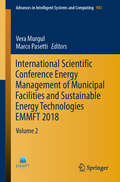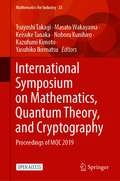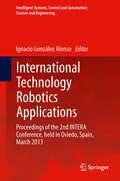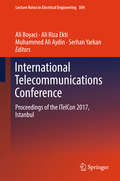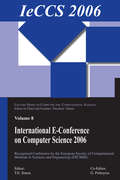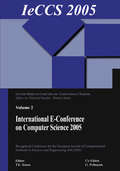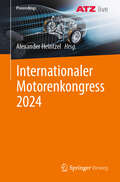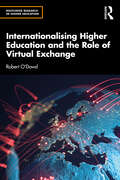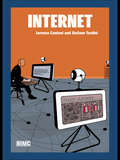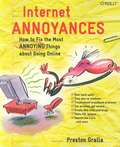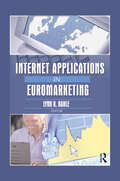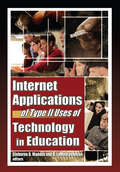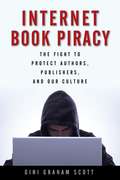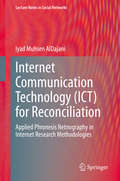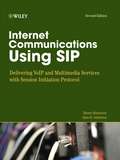- Table View
- List View
International Scientific Conference Energy Management of Municipal Facilities and Sustainable Energy Technologies EMMFT 2018: Volume 2 (Advances in Intelligent Systems and Computing #983)
by Vera Murgul Marco PasettiThis book presents a collection of the latest studies on and applications for the sustainable development of urban energy systems. Based on the 20th International Scientific Conference on Energy Management of Municipal Facilities and Sustainable Energy Technologies, held in Voronezh and Samara, Russia from 10 to 13 December 2018, it addresses a range of aspects including energy modelling, materials and applications in buildings; heating, ventilation and air conditioning systems; renewable energy technologies (photovoltaic, biomass, and wind energy); electrical energy storage; energy management; and life cycle assessment in urban systems and transportation.The book is intended for a broad readership: from policymakers tasked with evaluating and promoting key enabling technologies, efficiency policies and sustainable energy practices, to researchers and engineers involved in the design and analysis of complex systems.
International Symposium on Computer and Information Sciences
by Erol GelenbePapers from an October 2002 symposium describe research in areas including algorithms, artificial intelligence, computer graphics, computer networks, databases, evolutionary computation, graph theory, image processing, multimedia technology, software engineering, and software performance engineering
International Symposium on Intelligent Informatics: Proceedings of ISI 2022 (Smart Innovation, Systems and Technologies #333)
by Kuan-Ching Li Sabu M. Thampi Jayanta Mukhopadhyay Marcin PaprzyckiThis book constitutes thoroughly refereed post-conference proceedings of the 7th International Symposium on Intelligent Informatics (ISI 2022), from August 31 to September 1–2, 2022, Trivandrum, India. The revised papers presented are carefully reviewed and selected from several initial submissions. The scope of the Symposium includes AI, machine learning, cognitive computing, soft computing, security informatics, data science, computer vision, pattern recognition, intelligent software engineering, intelligent networked systems, IoT, cyber-physical systems, and NLP. The book is directed to the researchers and scientists engaged in various fields of intelligent informatics.
International Symposium on Mathematics, Quantum Theory, and Cryptography: Proceedings of MQC 2019 (Mathematics for Industry #33)
by Tsuyoshi Takagi Masato Wakayama Keisuke Tanaka Noboru Kunihiro Kazufumi Kimoto Yasuhiko IkematsuThis open access book presents selected papers from International Symposium on Mathematics, Quantum Theory, and Cryptography (MQC), which was held on September 25-27, 2019 in Fukuoka, Japan. The international symposium MQC addresses the mathematics and quantum theory underlying secure modeling of the post quantum cryptography including e.g. mathematical study of the light-matter interaction models as well as quantum computing.The security of the most widely used RSA cryptosystem is based on the difficulty of factoring large integers. However, in 1994 Shor proposed a quantum polynomial time algorithm for factoring integers, and the RSA cryptosystem is no longer secure in the quantum computing model. This vulnerability has prompted research into post-quantum cryptography using alternative mathematical problems that are secure in the era of quantum computers. In this regard, the National Institute of Standards and Technology (NIST) began to standardize post-quantum cryptography in 2016. This book is suitable for postgraduate students in mathematics and computer science, as well as for experts in industry working on post-quantum cryptography.
International Taxation Law in Sports Events: An Income Tax Analysis
by Alara Efsun YazıcıoğluThis book is the first academic contribution that deals with international taxation of income sources from sports events.Using an interdisciplinary approach, with in-depth analysis of both sports law and international tax law, it is notably the first academic work to conduct a thorough analysis in the fields of international taxation of eSports, sports betting as well as illegal/unlawful income sources that may be obtained in relation to a sporting event, such as kickback payments. After describing the general methodologies of income tax and VAT from an international standpoint, defining key terms such as ‘eSports’ and ‘bidding procedure’, the book examines in detail the taxation of the services that are rendered and the goods that are sold, thereby the income obtained, in relation to an international sports event from both income tax and VAT perspectives. Also analysed are government funding in the sports sector, along with its taxation modalities, as well as specific tax exemption regulations enacted for the purposes of mega sporting events. Highlighting the absence of an acceptable level of certainty in the field of taxation of international sports events, the work makes pertinent suggestions as to the future of international sporting event taxation law.With international appeal, this comprehensive book constitutes essential reading for tax and sports law scholars.
International Technology Robotics Applications
by Ignacio González AlonsoThis book presents the latest scientific research related to the field of Robotics. It involves different topics such as biomedicine, energy efficiency and home automation and robotics. The book is written by technical experts and researchers from academia and industry working on robotics applications. The book could be used as supplementary material for courses related to Robotics and Domotics.
International Telecommunications Conference: Proceedings of the ITelCon 2017, Istanbul (Lecture Notes in Electrical Engineering #504)
by Ali Boyaci Ali Riza Ekti Muhammed Ali Aydin Serhan YarkanThis book collects one of the global premier scientific gatherings on telecommunications, signal processing, data networks, security, and optimization. It presents the proceedings of the International Telecommunications Conference 2017 (ITelCon 2017), held in Istanbul, Turkey from December 28 to 29, 2017. The proceedings include state-of-the-art studies that highlight major advances in the field of telecommunications and related branches. In addition, some of the contributions form the basis for 5G and beyond studies and standardization processes. The ITelCon conference brings together industry and academia participants from around the globe and promotes research, development, and applications in the field of telecommunications. It includes a far-reaching program supported by a variety of technical tracks on research, development, technology, design, services, and applications. The primary audience of ITelCon includes academics, experts and professionals from industry, as well as researchers in the field of telecommunications and relevant subfields.
International e-Conference of Computer Science 2006: Additional Papers from ICNAAM 2006 and ICCMSE 2006
by Theodore Simos Georgios PsihoyiosLecture Series on Computer and on Computational Sciences (LSCCS) aims to provide a medium for the publication of new results and developments of high-level research and education in the field of computer and computational science.In this series, only selected proceedings of conferences in all areas of computer science and computational sciences wil
International e-Conference on Computer Science (IeCCS 2005)
by Theodore SimosThe aim of IeCCS 2005, which was held in May 2005, was to bring together leading scientists of the international Computer Science community and to attract original research papers. This volume in the Lecture Series on Computer and Computational Sciences contains the extended abstracts of the presentations. The topics covered included (but were not limited to): Numerical Analysis, Scientific Computation, Computational Mathematics, Mathematical Software, Programming Techniques and Languages, Parallel Algorithms and its Applications, Symbolic and Algebraic Manipulation, Analysis of Algorithms, Problem Complexity, Mathematical Logic, Formal Languages, Data Structures, Data Bases, Information Systems, Artificial Intelligence, Expert Systems, Simulation and Modeling, Computer Graphics, Software Engineering, Image Processing, Computer Applications, Hardware, Computer Systems Organization, Software, Data, Theory of Computation, Mathematics of Computing, Information Systems, Computing Methodologies, Computer Applications and Computing Milieu.
Internationaler Motorenkongress 2024 (Proceedings)
by Alexander HeintzelIn diesem Tagungsband werden von anerkannten Experten der Automobil- und Nutzfahrzeugbranche eine Fülle neuer technischer Lösungen aufgezeigt.Die Tagung ist eine unverzichtbare Plattform für den Wissens- und Gedankenaustausch von Forschern und Entwicklern aller Unternehmen und Institutionen.Der InhaltKlimagerechte Verbrennungsmotoren aus globaler Sicht.- Gesamtsystem Verbrennungsmotoren und Kraftstoffe: CO2-Neutralität, Emissionen, Elektrifizierung.- Nutzung von Wasserstoff und synthetischen Kraftstoffen.- Sektorübergreifende Lebenszyklus-Betrachtungen.Die ZielgruppenFahrzeug- und Motoreningenieure sowie Studierende, die aktuelles Fachwissen im Zusammenhang mit Fragestellungen ihres Arbeitsfeldes suchen - Professoren und Dozenten an Universitäten und Hochschulen mit Schwerpunkt Kraftfahrzeug- und Motorentechnik - Gutachter, Forscher und Entwicklungsingenieure in der Automobil- und ZulieferindustrieDie VeranstalterATZlive steht für Spitzenqualität, hohes Niveau in Sachen Fachinformation und ist Bestandteil von Springer Nature. Hier wird unter einem Dach das Know-how der renommiertesten Wirtschafts-, Wissenschafts- und Technikverlage Deutschlands vereint. VDI Wissensforum vermittelt als ein führender Weiterbildungsspezialist das Wissen aus praktisch allen Technikdisziplinen und den wichtigsten außerfachlichen Gebieten. Dabei wird großer Wert auf Nachhaltigkeit und Praxisrelevanz gelegt.
Internationalising Higher Education and the Role of Virtual Exchange (Routledge Research in Higher Education)
by Robert O'DowdThis volume introduces Virtual Exchange (VE) as an innovative form of online intercultural learning and investigates the myriad of ways VE is being carried out across universities, ultimately arguing for its integration into university internationalisation policies and course curricula. Against the backdrop of increased digitalisation initiatives throughout universities given the effects of the pandemic, chapters focus not only on providing new research findings, but also on providing a comprehensive introduction and argumentation for the use of VE in university education and also in demonstrating how it can be put into use by both university decision-makers and educators. Reviewing the limitations of the activity, this timely work also fundamentally posits how VE and blended mobility more broadly could be developed in future higher education initiatives. This book will be of interest to researchers, academics, scholars, and students involved with Open & Distance Education and eLearning, approaches to internationalisation in education, and the study of higher education more broadly. Those interested in innovative methods for teaching and learning, as well as educational research, will also benefit from this volume.
Internet
by Lorenzo Cantoni Stefano TardiniFrom music to gaming, information gathering to eLearning; eCommerce to eGovernment, Lorenzo Cantoni and Stefano Tardini's absorbing introduction considers the internet as a communication technology; the opportunities it affords us, the limitations it imposes and the functions it allows. Internet explores: the political economy of the internet hypertext computer mediated communication websites as communication conceptualizing users of the internet internet communities and practices. Perfect for students studying this modern phenomenon, and a veritable e-feast for all cyber junkies.
Internet Access in Vehicular Networks
by Haibo Zhou Xuemin (Sherman) Shen Wenchao XuThis book introduces the Internet access for vehicles as well as novel communication and computing paradigms based on the Internet of vehicles. To enable efficient and reliable Internet connection for mobile vehicle users, this book first introduces analytical modelling methods for the practical vehicle-to-roadside (V2R) Internet access procedure, and employ the interworking of V2R and vehicle-to-vehicle (V2V) to improve the network performance for a variety of automotive applications. In addition, the wireless link performance between a vehicle and an Internet access station is investigated, and a machine learning based algorithm is proposed to improve the link throughout by selecting an efficient modulation and coding scheme.This book also investigates the distributed machine learning algorithms over the Internet access of vehicles. A novel broadcasting scheme is designed to intelligently adjust the training users that are involved in the iteration rounds for an asynchronous federated learning scheme, which is shown to greatly improve the training efficiency. This book conducts the fully asynchronous machine learning evaluations among vehicle users that can utilize the opportunistic V2R communication to train machine learning models. Researchers and advanced-level students who focus on vehicular networks, industrial entities for internet of vehicles providers, government agencies target on transportation system and road management will find this book useful as reference. Network device manufacturers and network operators will also want to purchase this book.
Internet Annoyances
by Preston GrallaWhat began as an intrepid U.S. Government initiative in the early 1970's has turned into a global way of life. Indeed, with more than 500 million current users (and counting), the Internet has revolutionized the way societies function the world over. From dating and shopping online, to conducting informational research, to communicating via email, today seemingly everyone uses the Internet for one purpose or another. How, then, can something so vast and powerful be defiled by something as trivial as spam? It's true. The fact remains that despite the leading-edge technological sophistication fueling the Net, there are still many related annoyances that complicate and tarnish the Internet experience. And it doesn't matter if you're a homemaker in search of a fresh chicken recipe, or a civil engineer researching plans for a new skyscraper, the problems are the same. Internet Annoyances understands the universal nature of the Internet and strives to make its use as stress-free as possible. This insightful guide shows you how to overcome the most annoying Internet-related quirks, bugs, and hassles. You'll learn how to make a seamless connection, thwart would-be hackers, ensure greater security while surfing, eliminate pop-up ads, maximize online services, conduct more effective Google searches, better utilize digital media (music and video), and much more. In addition, Internet Annoyances discusses how to design and host a personal web site something once thought of as only possible for the technically gifted. Topics like blogs, domain names, setup, HTML, fonts, and graphics and are all dissected and analyzed for easy consumption. Unlike other books on the subject, Internet Annoyances assumes readers already possess a working knowledge of the Internet. By fully recognizing the experience level of today's Internet culture, author Preston Galla is able to cut immediately to the chase and not waste time on the more obvious points. Internet Annoyances , therefore, is a quick read that presents succinct solutions for the many glitches that still populate the Internet experience.
Internet Applications in Euromarketing
by Lynn R. Kahle Erdener KaynakExplore Internet marketing from cross-cultural and cross-national perspectives! This book examines cutting-edge theory and practice on Internet marketing, putting the latest research on the best ways to exploit this interactive advertising medium in your hands. In Internet Applications in Euromarketing, scholars from Europe and the United States examine essential facets of Internet use, both as a means of product promotion and as a facilitator of consumers? purchasing decisions. Internet Applications in Euromarketing considers the effectiveness of combining Web advertising with traditional media, looks at ways to make banner ads pay off, highlights techniques for reaching older consumers via the Internet, shows how to take advantage of online word-of-mouth advertising, and more! The handy charts and tables in this well-referenced book make important points of information easy to access and understand. Internet Applications in Euromarketing looks in-depth at what works and what doesn?t, addressing the questions on marketers? minds (and some that many haven?t thought of yet), including: Where is a company?s marketing money best spent?what are the media effects for Internet exposure vs. television and print? Is it useful to mention a price, a rebate, or a gift to encourage the Internet user to move from the banner?s host site to the brand?s site? What are the Internet habits and preferences of seniors, and what are the best ways to reach them? Are banner ads that are disguised as messages from the user?s operating system more effective than those that simply appear as advertising? How can we generate word-of-mouth Internet communication?via e-mail, newsgroups, bulletin boards, chat rooms, etc.?and establish credibility? What are the advantages of online discussions over traditional focus groups?
Internet Applications of Type II Uses of Technology in Education
by Cleborne D. Maddux D. LaMont JohnsonGive your students a powerful learning resource-the Internet!The Internet, though brimming with potential, is still vastly underused as a teaching resource. Internet Applications of Type II Uses of Technology in Education gives teachers new strategies for the Internet&’s use as a dynamic educational resource. Where Type I teaching applications technologically mimic the procedures previously used by teachers, Type II teaching applications involve innovative thinking in the use of technology in learning. Using Type II applications with the Internet, students are actively empowered to look to its use as an effective partner in their learning process. This book clearly reviews several Type II teaching applications and integrative software for use in all educational levels, including Internet videoconferencing, instant messages, WebQuests, and WebCT.Though now readily available, even those schools with the capability fail to effectively integrate computer and Internet technology into meaningful classroom activities. Using the Internet as a teaching and learning tool offers a flexibility that can be extremely effective. Internet Applications of Type II Uses of Technology in Education clearly shows how some creative educators have implemented inventive Type II applications in their teaching plans to give their students a more enriching learning experience.Internet Applications of Type II Uses of Technology in Education explores: critically evaluating Web site information how perceptions and behaviors change when Internet access becomes universally available Internet2 Videoconferencing integrating online communication into courses utilizing computer-mediated communication (CMC) tools structured online class discussions using Instant Messenger (IM) increasing vocabulary through software and online texts online learning in second-language acquisition (SLA) a project in New Zealand in which teachers and students learn Web design with the help of an external expert WebQuests as a Type II application WebCT as a Type II application achievement testing through the computer the Global Forum on School Leadership (GFSL) as a Type II applicationInternet Applications of Type II Uses of Technology in Education is a valuable, idea-generating resource for all academics working in information technology and education, and for K-12 teachers and administrators at all levels.
Internet Book Piracy: The Fight to Protect Authors, Publishers, and Our Culture
by Gini Graham ScottThe international battle against Internet pirates has been heating up. Increasingly law enforcement is paying attention to book piracy as ebook publishing gains an ever-larger market share. With this threat to their health and even survival, publishers and authors must act much like the music, film, and software giants that have waged war against pirates for the past two decades. Now, The Battle against Internet Piracy opens a discussion on what happens to the victims of piracy. Drawing from a large number of interviews-from writers, self-publishers, mainstream publishers, researchers, students, admitted pirates, free speech advocates, attorneys, and local and international law enforcement officials-the text speaks to such issues as: Why pirates have acted and how they feel about it The conflict over constitutional rights and piracy The current laws surrounding Internet piracy Examples of cases taken against some pirates Alternatives to piracy Personal experiences of being ripped off The ways piracy affects different industries and how they’ve respondedAuthor Gini Graham Scott prepares readers to arm themselves against these modern perils by learning about copyright, infringement, and how to prevent, combat, and end book piracy.Allworth Press, an imprint of Skyhorse Publishing, publishes a broad range of books on the visual and performing arts, with emphasis on the business of art. Our titles cover subjects such as graphic design, theater, branding, fine art, photography, interior design, writing, acting, film, how to start careers, business and legal forms, business practices, and more. While we don't aspire to publish a New York Times bestseller or a national bestseller, we are deeply committed to quality books that help creative professionals succeed and thrive. We often publish in areas overlooked by other publishers and welcome the author whose expertise can help our audience of readers.
Internet Branding For Lawyers: Building The Client-centered Website
by Jeff LantzCovering methods applicable to firms serving individuals as well as firms serving businesses, this reader-friendly guide shows how to create a brand and a website for a law firm. Lantz, a consultant in brand creation and website development who holds an MBA in finance, advises readers to focus on the customer perspective: how will you help me and how much will it cost. The book begins by explaining the increased importance of branding in today's information age, then explains how to build a brand around the law firm's practices and how to communicate the brand through website content and design. The final section of the book is given over to technical details and decisions related to areas such as content management systems, choosing a website developer, search optimization, domain names, and servers and website hosting. The book includes many bullets and checklists, along with b&w photos, screenshots, and examples of logos. Annotation ©2012 Book News, Inc. , Portland, OR (booknews. com)
Internet Child Abuse: Current Research and Policy
by Julia DavidsonInternet Child Abuse: Current Research and Policy provides a timely overview of international policy, legislation and offender management and treatment practice in the area of Internet child abuse. Internet use has grown considerably over the last five years, and information technology now forms a core part of the formal education system in many countries. There is however, increasing evidence that the Internet is used by some adults to access children and young people in order to ‘groom’ them for the purposes of sexual abuse; as well as to produce and distribute indecent illegal images of children. This book presents and assesses the most recent and current research on internet child abuse, addressing: its nature, the behaviour and treatment of its perpetrators, international policy, legislation and protection, and policing. It will be required reading for an international audience of academics, researchers, policy-makers and criminal justice practitioners with interests in this area.
Internet Communication Technology: Applied Phronesis Netnography in Internet Research Methodologies (Lecture Notes in Social Networks)
by Iyad Muhsen AlDajaniThe book explores Applied Phronesis in internet communication technology and Netnography application, introducing it on Facebook and YouTube usages. It defines two pillars for the research dynamics, “Episteme” and “Techne.” – the know-how, how-to, and the power dynamics. The “Episteme” explores the dynamics of reconciliation in the middle of conflict, Internet communication technologies for transformation, Moderation in Islam, online Deliberative Democracy.The second pillar, “Techne,” is explored through Internet communication technology for the advancement of reconciliation in the middle of a conflict.The book describes the Phronetic Approach in internet research in academic discourse adopting Phronesis “an Aristotelian concept and method defined by Bent Flyvbjerg,” and exploring Netnography for Kozinets, in Mixed-Method research design and applying methodological triangulation in research and testing the hypothesis using qualitative content analysis for Krippendorff, developing a methodological discourse for interdisciplinary research using internet communication technologies as part of understanding big-date, introducing Applied Digital Humanities.
Internet Communications Using SIP
by Henry Sinnreich Alan B. Johnston"This book is like a good tour guide.It doesn't just describe the major attractions; you share in the history, spirit, language, and culture of the place."--Henning Schulzrinne, Professor, Columbia UniversitySince its birth in 1996, Session Initiation Protocol (SIP) has grown up. As a richer, much more robust technology, SIP today is fully capable of supporting the communication systems that power our twenty-first century work and life.This second edition handbook has been revamped to cover the newest standards, services, and products. You'll find the latest on SIP usage beyond VoIP, including Presence, instant messaging (IM), mobility, and emergency services, as well as peer-to-peer SIP applications, quality-of-service, and security issues--everything you need to build and deploy today's SIP services.This book will help you* Work with SIP in Presence and event-based communications* Handle SIP-based application-level mobility issues* Develop applications to facilitate communications access for users with disabilities* Set up Internet-based emergency services* Explore how peer-to-peer SIP systems may change VoIP* Understand the critical importance of Internet transparency* Identify relevant standards and specifications* Handle potential quality-of-service and security problems
Internet Computing and IoT and Embedded Systems, Cyber-physical Systems, and Applications: 25th International Conference, ICOMP 2024, and 22nd International Conference, ESCS 2024, Held as Part of the World Congress in Computer Science, Computer Engineering and Applied Computing, CSCE 2024, Las Vegas, NV, USA, July 22–25, 2024, Revised Selected Papers (Communications in Computer and Information Science #2260)
by Hamid R. Arabnia Leonidas Deligiannidis Soheyla Amirian Farzan Shenavarmasouleh Farid Ghareh MohammadiThis book constitutes the proceedings of the 25th International Conference on Internet Computing and IoT, ICOMP 2024, and the 22nd International Conference on Embedded Systems, Cyber-physical Systems, and Applications, ESCS 2024, held as part of the 2024 World Congress in Computer Science, Computer Engineering and Applied Computing, in Las Vegas, USA, during July 22 to July 25, 2024. The 23 papers from IVOMP 2024 have been carefully reviewed and selected from 122 submissions. ESCS 2024 received 49 submissions and accepted 11 papers for inclusion in the proceedings. The papers have been organized in topical sections as follows: Internet computing and IoT - Cloud and Internet of Things; Internet computing and IoT - algorithms and applications; and embedded systems, cyber-physical systems and applications.
Internet Computing: Principles of Distributed Systems and Emerging Internet-Based Technologies
by Ali SunyaevThe 2nd edition of this well-established textbook introduces the reader to the fundamentals of contemporary and emerging technologies and services in Internet computing. It covers essential concepts such as distributed systems architecture and web technologies, contemporary paradigms such as cloud, fog, and edge computing, the Internet of things, and emerging technologies like distributed ledger technologies and the InterPlanetary File System. The book also highlights the interconnection and recombination of these Internet-based technologies, which together form a critical information infrastructure with major impacts on individuals, organizations, governments, economies, and society as a whole. Intended as a textbook for upper undergraduate and graduate classes, it features a wealth of examples, learning goals and summaries for every chapter, numerous recommendations for further reading, and questions for checking students’ comprehension. A dedicated author website offers additional teaching material and more elaborate examples. Accordingly, the book enables students and young professionals in IT-related fields to familiarize themselves with the Internet’s basic mechanisms, and with the most promising Internet-based technologies of our time.
Internet Core Protocols: Help for Network Administrators
by Eric HallIf you've ever been responsible for a network, you know that sinking feeling: your pager has gone off at 2 a.m., the network is broken, and you can't figure out why by using a dial-in connection from home. You drive into the office, dig out your protocol analyzer, and spend the next fourhours trying to put things back together before the staff shows up for work.When this happens, you often find yourself looking at the low-level guts of the Internet protocols: you're deciphering individual packets, trying to figure out what is (or isn't) happening. Until now, the only real guide to the protocols has been the Internet RFCs--and they're hardlywhat you want to be reading late at night when your network is down. There hasn't been a good book on the fundamentals of IP networking aimed at network administrators--until now.Internet Core Protocols: The Definitive Guide contains all the information you need for low-level network debugging. It provides thorough coverage of the fundamental protocols in the TCP/IP suite: IP, TCP, UDP, ICMP, ARP (in its many variations), and IGMP. (The companion volume, Internet Application Protocols: The Definitive Guide,provides detailed information about the commonly used application protocols, including HTTP, FTP, DNS, POP3, and many others). It includes many packet captures, showing you what to look for and how to interpret all the fields. It has been brought up to date with the latest developments in real-world IP networking. The CD-ROM included with the book contains Shomiti's "Surveyor Lite," a packet analyzer that runs on Win32 systems, plus the original RFCs, should you need them for reference. Together, this package includes everything you need to troubleshoot your network--except coffee.
Internet Corporation for Assigned Names and Numbers im internationalen Rechtssystem: Wie diese die Europäische Datenschutz-Grundverordnung umsetzt und welchen Einfluss die Umsetzung auf das E-Mail-Marketing hat (BestMasters)
by Tobias SattlerFür den stabilen und sicheren Betrieb des Internets ist die US-amerikanische gemeinnützige Organisation Internet Corporation for Assigned Names and Numbers (ICANN) verantwortlich, wozu die Koordination der Vergabe von Domain-Namen gehört. Die Europäische Datenschutz-Grundverordnung (EU-DSGVO) dient der Vereinheitlichung des Datenschutzrechts und schützt die Verarbeitung von personenbezogenen Daten. Dies hat einen Einfluss auf die öffentlich zugänglichen Informationen von registrierten Domain-Namen, deren Veröffentlichung die ICANN in ihren Richtlinien vorschreibt. Diese Informationen umfassen personenbezogene Daten wie den Namen, die Postanschrift und die E-Mail-Adresse der Domain-innehabenden Person. Die ICANN änderte ihre Richtlinien, jedoch ist weiterhin die Veröffentlichung dieser Angaben möglich. In dem vorliegenden Buch werden die Auswirkungen der EU-DSGVO auf das E-Mail-Marketing und die Verwendung von E-Mail-Adressen für E-Mail-Kampagnen untersucht, insbesondere in Bezug auf unerwünschte E-Mail-Werbung. Dazu wird die folgende Forschungsfrage gestellt: Welchen Effekt hat die Veröffentlichung der E-Mail-Adresse der Domain-innehabenden Person in den WHOIS-Datenbanken auf die Anzahl eingehender unerwünschter Marketing-E-Mails?
